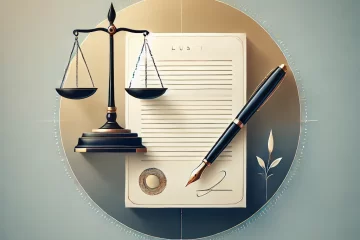![]()
Introduction:
Contempt of court is a term aimed at defending judicial institutions from motivated assaults and unjustified criticism and is a legal framework for punishing those who have reduced their authority. Contempt of court is categorised as civil and criminal by the statute codifying contempt. Civil contempt is carried out when a person disobeys a court order willfully or violates any undertaking given by him/her to the court willfully.[1] A contempt of court is a matter relating to the administration of justice and the reputation and control of judicial tribunals.[2]The objective of law relating to contempt of court is to make the process of administration of justice flawless.[3]
Things that scandalize the judiciary are generally considered to be making accusations against the Court or the Judges, attributing intention to decisions and judicial functioning, and any scurrilous assault on the actions taken by judges.[4] The reason for this clause is that courts should be shielded from tendentious assaults that diminish their legitimacy, defame their image before the public and make the public lose trust in their impartiality.[5]
Historical Background
It is possible to trace the roots of contempt law in India back to the pre-independence period. No definition of contempt was included in the Contempt of Courts Act, 1926 and the Contempt of Courts Act, 1952. The High Courts and the Supreme Court applied the principles of general common law relating to the law of contempt, but the amount of punishment levied by those courts was limited by those Acts.[6] In Legal Remembrancer v. Matilal Ghose,[7] The Court acknowledged that “arbitrary, unlimited and uncontrolled” was the power of punishment for contempt and should therefore be “exercised with the greatest caution.”
Before the Contempt of Courts Act of 1926 came into effect, there was a difference of opinion between the various High Courts over their power to prosecute subordinate courts for contempt.[8] The Act of 1926 was repealed and replaced by the Contempt of Courts Act, 1952, which rendered major deviations from the previous Act. The 1952 Act was replaced in 1971 by the Contempt of Courts Act, 1971.[9]
Among other provisions, the aforementioned Act 1971 categorizes contempt into two parts, i.e. “civil contempt” and “criminal contempt,” including clear meanings for both heads.[10] Some exceptions were also made for suggesting directions for commenting& reporting on proceedings of Court which would have not drawn the attention of the act’s provisions. For example, a person cannot be charged with contempt if he is publishing an accurate report of the proceeding of court[11] and criticizing the act of court fairly if the case has been finalized and decided by the court.[12] It has been given in the act that an act cannot be punished until and unless it substantially interferes with the proper course of justice or tends to interfere with the proper course of justice.[13] A limitation period for starting the contempt proceedings is also given in the act.[14]
International Scenario
Pakistan
In Pakistan, the Contempt of Court Act, 1926 was the key legislation in the region which was later replaced by the Contempt of Courts Act of 1976. The act of 1976 was replaced in 2003 by the Contempt of Court Ordinance of 2003. This ordinance was also replaced in 2012 by the Contempt of Courts Act of 2012. Under this act of 2012, various exception was made. It was made inapplicable to people holding public offices including Prime Minister. The term “scandalizing the judge with respect to his office” replaced the term “scandalizing the court”. However, in Baz Muhammed Kakar v. Federation of Pakistan etc.,[15] the apex court of the country held the act of 2012 to be violative of provisions of the Constitution.
Walesand England
Under English law, the Contempt of Court Act of 1981 deals with the offence of contempt of court. It also categorizes the offence into civil and criminal contempt. The act sets maximum punishment for the offence as 2 years. The Law, under S. 1, gives the “strict liability rule” where any act which interferes with the administration of justice in any proceeding of the court can be regarded as contempt irrespective of the individual’s intention to do the same.[16]
In 2012, a report on powers relating to contempt was released by the Law Commission of the United Kingdom. Under the same, it was specifically proposed that the crime of “scandalizing the Court” be removed as a basis for criminal contempt. Its findings were adopted in 2013 and the offence was removed by the amendment act.[17]
USA
In the USA, “contempt of court” means conduct of disobedience or disrespect to the government’s judicial branch or an interference with its orderly procedure. It is considered as an act against the court or any judicial officer.[18]
The offence in the USA is also classified as civil and criminal contempt. However, the offence is also classified as direct contempt and indirect contempt. Former occurs in the presence of Judicial Officer or the Court while the latter occurs indirectly and not in the presence of the Judicial Officer or the Court. In the USA, the maximum punishment for the offence is prescribed as 14 years by the law.[19]
India
Constitutional Provisions
It is very well-founded that the “rule of law” is a fundamental aspect of the Constitution of the country.[20] The law of contempt guarantees the respect and honour of the Judiciary in the eyes of the citizens of the country by ensuring punishment against actions that could assault the dignity and respect of the courts. It ensures that the courts perform their duties without any fear.[21] In Kapildeo Prasad Sah v. State of Bihar,[22] the court ruled that it would be a breach of the Rule of Law principle to disobey the court’s order. However, the law of contempt should be put into action judiciously and should not be operated as a way of pursuing vengeance.[23]
As per the Constitution, both the apex court and High Courts are designates as the Courts of Record. In addition, it gives these Courts the power to prosecute themselves for contempt. Article 129 of the Constitution of India gives the Supreme Court the power to punish for its contempt.[24] Article 215 confers on the High Court similar power.[25] Under Art. 235, the High Courts are also provided with supervisory power over the subordinate courts. In this way, within its jurisdiction, the High Court is the protector of a subordinate judiciary.
The right to freedom of speech and expression under Art. 19 does not require the freedom of a court to commit contempt[26]. And, in order to exercise the right to freedom of speech and expression pursuant to Article 19(1)(a), if an individual attempts to assault the integrity of a court or to weaken its authority, the court may, as the case may punish him/her for contempt pursuant to Article 129 or Article 215. Any legislation passed by Parliament or the enforcement of any current law relating to contempt of justice will constitute a reasonable infringement on freedom of speech and expression.[27]Even while the pending course of the case proceedings, the defence of fair comment is available.[28]
The Contempt of Courts Act, 1971
The act of 1971 was enacted on the recommendations of the Sanyal Committee Report of 1963. An analysis of the “Statement of Objects and Reasons” of the aforementioned Act of 1971 reveals that the previous acts on the Contempt was vague, ambiguous and not satisfactory, also, it highly affected the right to personal freedom and the right to freedom of speech and expression of the citizens.
Section 2: The offence of contempt is described under section 2 which categorises it into “civil contempt” and “criminal contempt.” Any action that gives a judge an inappropriate motive or any scurrilous harassment of a judge would scandalize the court under S. 2(c)(i) of the Act.[29] Any speech that tends to affect the outcome of a pending proceeding is considered as contempt. In general, such remarks by the parties involved or their attorneys on the pending proceedings represent more extreme contempt than those by any impartial source.[30]
Section 10: Talks about the contempt of subordinate courts. It gives powers to High Court to take action against the contempt of court subordinate to it and also contempt of itself.
Section 12: It specifies the punishment for the offence. It also prescribes punishment where the contemnor is a business.
Section 14 and 15: In section 14, the process of dismissal with respect to the proceedings of the court are given. In section 15, the process with respect to criminal contempt is provided other than that is prescribed in section 14.
Section 16: Section 16 deals with the contempt with respect to the judicial officer in his official capacity. A judge can foul the judicial administration while discharging a judge’s duties by misdemeanours.[31]
Section 22: This section states that the provisions of the Act are complementary to the provisions of every other current law involving contempt of justice.
Compared to the scenario previous to the Act of 1926, the Act provides for a fair process and limits the jurisdiction of the courts with respect to contempt of courts. With the passage of clear disregard of court laws, starting with the Act of 1926, and subsequently with those of 1952 and 1971, the court’s power to enforce a penalty for disregard of the court ceased to be unregulated or unrestricted.
2006 Amendment
In the past, it has been held that the defence of fair comments, as permitted by Section 5 or as a general defence,[32] does not extend to charges of misconduct or unfair criticism against the judiciary.[33] It is argued that this narrow, pedantic approach needs judicial reconsideration in the light of the recent amendment enabling the alleged contemporaries to protect the facts as a shield. Section 13 was amended by the 2006 Amendment Act to include Section 13(b), which states, ‘In any proceeding for contempt of court, the court can accept truthful reason as a legitimate defence if it is satisfied that it is in the public interest and that the request to invoke the defence is bona fide.’
Conclusion
Although the right of the judiciary to exercise its power of contempt over individuals who obstruct the administration of justice is respected, it is argued that certain elements of that jurisdiction that go to suppress criticism of the judiciary in India need correction, since, as Winston Churchill famously observed, criticism may not be appropriate, but it is required. It fulfils the same role in the human body as pain. This draws attention to an unhealthy state of affairs.[34]
References:
[1] K. Venkataramanan, What is contempt of court?, The Hindu (12 Feb, 2021, 13:23 PM), https://www.thehindu.com/news/national/the-hindu-explains-what-is-contempt-of-court/article32249810.ece.
[2] A. Ramalingam v. V.V.M. Mahalinga Nadar, AIR 1966 Mad 21.
[3]Bineet Kumar Singh, In re, (2001) 5 SCC 501.
[4] A. Ramalingam v. V.V.M. Mahalinga Nadar, AIR 1966 Mad 21.
[5] Ibid.
[6] M. Jagannadha Rao, The Law of Contempt in Light of Sahara v. Sebi, National Law School of India Review , 2013, Vol. 25, No. 1, pp. 1-26 (2013), https://www.jstor.org/stable/44283619.
[7] 1913 SCC Online Cal 443.
[8]Ibid.
[9]Review of the Contempt of Courts Act, 1971 (Limited to Section 2 of the Act), Law Commission of India, Report No. 274 (April, 2018).
[10]Contempt of Court Act, 1971, No. 70, Act of Parliament, § 2 (1971).
[11]Contempt of Court Act, 1971, No. 70, Act of Parliament, § 4 (1971).
[12]Contempt of Court Act, 1971, No. 70, Act of Parliament, § 5 (1971).
[13]Contempt of Court Act, 1971, No. 70, Act of Parliament, § 13 (1971).
[14]Contempt of Court Act, 1971, No. 70, Act of Parliament, § 20 (1971).
[15] Judgment and Order dated 3-8-2012 in Constitution Petition No. 77 of 2012, PLD 2012 SC 923.
[16] Available at https://www.legislation.gov.uk/ukpga/1981/49 (last accessed on 12 Feb, 2021, 11:52 PM).
[17]Contempt of Court: Scandalising the Court, The Law Commission, No. 335 (2012), Available athttps://www.gov.uk/government/uploads/system/uploads/attachment_data/file/246860/0839.pdf (last accessed on 12 Feb, 2021, 13:22 PM).
[18] Available at https://www.justice.gov/usam/usam-9-39000-contempt-court (Last Accessed on 12 Feb, 2021, 13:42 PM).
[19] Chadwick v. Janecka, 312 F 3d 597 (2002).
[20]Kesavananda Bharati Sripadagalvaru v. State of Kerala, (1973) 4 SCC 225.
[21] Vinay Chandra Mishra, In re, (1995) 2 SCC 584.
[22] (1999) 7 SCC 569.
[23]Arundhati Roy, In re, (2002) 3 SCC 343.
[24] Constitution of India, Art. 129 (1950).
[25]Constitution of India, Art. 215 (1950).
[26] State of Bombay v. P., AIR 1959 Bom 182.
[27] J.R. Parashar v. Prasant Bhushan, (2001) 6 SCC 735.
[28] Rama DayalMarkarha v. State of M.P., (1978) 2 SCC 630.
[29] Rajesh Kumar Singh v. High Court of Judicature of M.P., (2007) 14 SCC 126.
[30] S.A. Khan v. Bhajan Lal, (1993) 3 SCC 151.
[31]Baradakanta Mishra v. Orissa High Court, (1974) 1 SCC 374.
[32]Samaraditya Pal, The Law of Contempt, Law Research Institute, 251-60(3rd Edn., 2001).
[33]Manik Chand Gupta v. Virendra Kumar, 1979 Cri LJ 412 (All).
[34] Jonathon Green, The Macmillan Dictionary of Contemporary Quotations, Macmillan, p. 229 (3rd Edn.,1996).



0 Comments